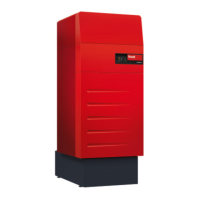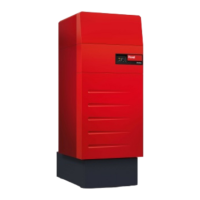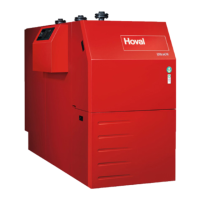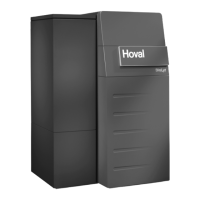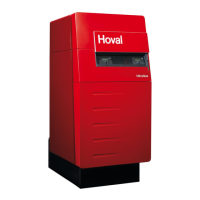Do you have a question about the Hoval SR-plus 500 and is the answer not in the manual?
Legal requirements for gas appliance installation and use.
List of relevant British Gas publications for installations.
Example of the boiler's identification plate details.
Instructions for receiving and safely storing the boiler.
Intended uses for heating and hot water supply.
Construction, design, and core features of the boiler.
Key advantages and operational benefits of the SR-plus range.
Information on changing the boiler door hinge orientation.
List of optional features and accessories available.
Details regarding the boiler's insulation and external cladding.
How the boiler operates normally and with BMS control.
Requirements for the boiler's single-phase power supply.
Technical data for SR-plus boiler models 500 to 1500.
Technical data for SR-plus boiler models 1750 to 4000.
Physical dimensions and connection points for models 500-900.
Explanation of numbered components in the boiler diagrams.
Summary of specifications for SR-plus models 500-900.
Physical dimensions and connection points for models 1200-4000.
Explanation of numbered components in the boiler diagrams.
Summary of specifications for SR-plus models 1200-4000.
Guidelines for adequate space around the boiler for access.
Specific minimum clearances for boiler installation and maintenance.
Important considerations for pipework and boiler casings.
Procedure for re-hinging the boiler door.
Information on noise sources and mitigation measures.
Requirements for boiler house ventilation systems.
Principles for natural air flow in boiler rooms.
Specifications for required ventilation inlet areas.
Guidelines for using mechanical ventilation systems.
Specific requirements for open vented heating systems.
Specific requirements for independently pressurised systems.
Advice on flue sizing and installation for multi-boiler plants.
Guidelines for using fan dilution systems where conventional flues are impractical.
Key considerations for determining chimney size and height.
Advice on filling systems with treated water.
Checklist for system filling procedures.
Necessity and methods of water treatment for heating systems.
Selecting CE-approved burners according to directives.
Step-by-step instructions for installing the burner.
Specific considerations for dual fuel burner installations.
Procedure for sealing the draught tube gap.
Information on fitting optional acoustic shrouds.
Correct location for the fire sensor.
Guidelines for setting water flow and return temperatures.
Explanation of components on the boiler control panel.
Operation of the burner control ON/OFF switch.
Setting and function of the safety limit thermostat.
Setting and function of the main control thermostat.
Indication and reset procedure for high temperature cutout.
Indication and reset procedure for burner lockout.
Information on terminals for external interlocks.
Crucial advice regarding standby gas booster installation.
General recommendations for booster placement and installation.
Advice on inspecting flexible piping for boosters.
Safety requirements for boosters in specific hazardous zones.
Essential pre-commissioning checks for the heating engineer.
List of checks performed by Hoval service engineers.
Ensuring compliance with burner manufacturer requirements.
Verifying controls and adjusting thermostats.
Safe initial firing procedure to prevent damage.
Optimizing burner performance and flame characteristics.
Opportunities for installer training during the commissioning process.
Information on the commissioning report provided to customers.
Essential information and notes for boiler operators.
Location and function of boiler instruments and controls.
Description of core control functions like sequence box and thermostats.
Managing multiple boilers under a BMS control system.
Procedures for starting up after cleaning or summer shutdown.
How the boiler operates during normal heating cycles.
Scope of work requiring a qualified service engineer.
Regular checks to be performed between main services.
Recommendations for comprehensive component checks at intervals.
Instructions for cleaning boiler heating surfaces.
Thorough cleaning of the boiler interior before long periods of inactivity.
Safety precautions and procedures for burner maintenance.
Correct fuel types for the burner as per nameplate.
How to use the emergency stop function.
Cleaning and lubrication of the burner motor.
Maintenance of the fan runner blades.
Operator-limited maintenance for these burner components.
Cleaning and inspection of the flame sensor.
Note that internal burner repairs require a qualified engineer.
Steps to diagnose and fix a burner that fails to start.
Steps to diagnose and fix burner lockout issues.
Steps to diagnose and fix rapid burner extinction.
Diagnosing issues causing smoky flames and overheating.
Note that internal burner repairs require a qualified engineer.
Steps to diagnose and fix a gas burner that fails to start.
Steps to diagnose and fix gas burner lockout.
Steps to diagnose and fix burner motor cycling issues.
Steps to diagnose and fix burner shutdown and recycle issues.
Steps to diagnose and fix gas burner shutdown lockout.
Diagnosing lockout after pilot ignition.
Steps to diagnose and fix gas leaks.
Diagnosing combustion noise and flame color issues.
| Type | Condensing Boiler |
|---|---|
| Heating Capacity | 500 kW |
| Fuel Type | Natural Gas / LPG |
| Operating Pressure | 6 bar |
| Category | Commercial |
| Efficiency | Up to 98% |







